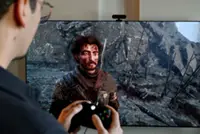When I heard Kuroda’s voice coming out of the mouth of an anthropomorphic rabbit, I had to play the game.
For hard-core gamers, Takaya Kuroda’s voice should sound familiar, though his name may not ring a bell. The Japanese voice actor brings Kazuma Kiryu to life in Like a Dragon and Yakuza. His work is heard in dozens of other video games and anime, but his deep and intimidating timbre is so distinct that fans immediately recognise him.
It’s one of the reasons that Rusty Rabbit piqued my interest when it was first unveiled. When I heard Kuroda’s voice coming out of the mouth of an anthropomorphic rabbit, I had to play the game. Initially, the campaign seems to follow the typical Metroidvania formula. Players take on the role of Stamp (voiced by Kuroda), a scavenger who digs through the ruins of Smokestack Mountain, using a mech he calls Junkster.
A different postapocalypse
He earns a living by finding screws, bolts and other parts in a postapocalyptic world where rabbits have inherited the Earth. Humanity has mysteriously disappeared and the bunnies evolved and developed a civilisation in the ruins. Stamp’s home base is Brass Village, which is equipped with small-town amenities such as a bar, hardware store, diner and church.
The creatures have set up a curious civilisation with a religion based around the adventures of Peter Rabbit. Players start off delving through a dungeon fighting rust beasts, when Stamp runs into a ragtag group of youngsters who call their gang BB. He helps them, and in the process, his Junkster is destroyed, and he has to rebuild it and make it more powerful in a campaign where he constantly runs across the youngsters.
As a grizzled veteran, he aids them when he can, but as he dives deeper in the ruins, players discover more about Stamp and his lost daughter. Slowly, the plot changes from a simple rebuilding mission into a rescue coated in a nefarious conspiracy.
An unusual structure
The narrative isn’t the only unconventional element. The story also reinforces Rusty Rabbit’s novel structure. Normally, Metroidvania titles are lonely experiences where the protagonist adventures across the map, acquires new powers and uses those abilities to access gated-off areas. It’s contemplative, almost like a solitary meditation about personal growth.
Rusty Rabbit is different because it’s centred on a town, and Stamp is a character that’s introduced as an isolated old man set in his ways. That perception changes as players venture into Smokestack Mountain, which is divided into more than 10 zones. Stamp traverse these dungeons, which feature plenty of save points and portals that return him to the village.
Players don’t wander a wide-open map, but rather they pick a location and explore it before moving on. They’ll scavenge junk to sell and level up Stamp so he acquires more skill points. He’ll also find blueprints that allow him to build more powerful weapons with scrap.
Because players operate in manageable chunky zones, it makes backtracking to unlock a new area more efficient. The structure also helps the campaign feel less lonely. Heading back to Brass Village is a requirement as players need to buy supplies and turn in quests at the Bar. Stamp can also chat up the locals at the Diner to earn more credits and unlock more Blueprints. As they interact with the inhabitants, players discover the lore in dense conversations.
It shows that Stamp isn’t a recluse, but part of a fabric of that society. He also takes on the role of the responsible adult watching over the young members of BB while also discover clues to the whereabouts to his estranged daughter. Not all the strands of the drama work, but it does enough to suck players into Rusty Rabbit’s spell.
Role-playing game elements and challenge
The role-playing game elements work similarly, becoming a hook that pulls players through the campaign. Every dungeon dive makes players feel as though they’re progressing and strengthening Stamp, through experience points. Players acquire them by drilling through rock and defeating enemies, levelling him up with skill points.
Although the structure and approach is clever, the rest of the campaign feels rote. Players have four distinct weapons that are needed to unlock different parts of Smokestack Mountain. Players will power up these weapons and gain new abilities that make traversal easier, further opening up areas to explore. Meanwhile, each zone is punctuated by boss fights that are unspectacular and fail to present much challenge, especially when players can buy potions.
The hardest part of Rusty Rabbit is figuring out where to go next after finishing one objective. Players can end up lost, unaware of what to do with a new ability, especially after the campaign broadens. A better way to track areas like the snapshot feature in Prince of Persia: The Lost Crown would have been helpful.
Nevertheless, Rusty Rabbit does present a refreshing approach to the genre but lacks a compelling vision to make it standout, even with the mesmerising voice of Kuroda. – Bay Area News Group/Tribune News Service









